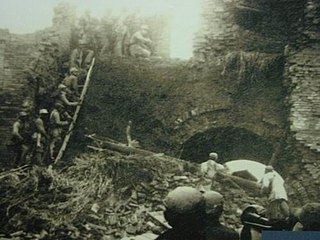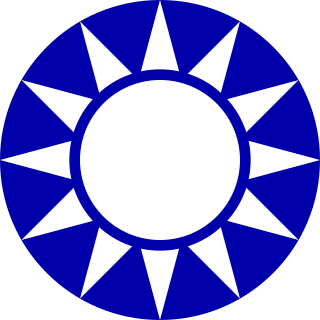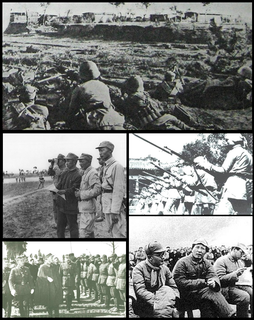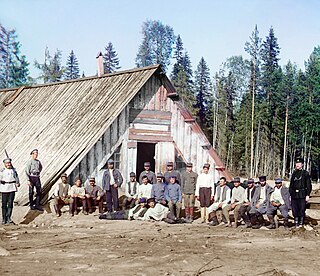
The Shangdang Campaign was a series of battles fought between the Communist force under the leadership of Liu Bocheng and the nationalist Yan Xishan's Kuomintang force. The Campaign lasted from September 10, 1945, through October 12, 1945. Like all other communist victories in the clashes immediately after Japanese's surrender in World War II, the outcome of this campaign altered the course of the peace negotiation held in Chongqing from August 28, 1945, through October 11, 1945, resulting in a more favourable outcome for Mao Zedong.

The Battle of Yijiangshan Islands was a conflict between forces of the National Revolutionary Army (NRA) of the Republic of China and the People's Liberation Army (PLA) of the People's Republic of China, over one of the last strongholds of Nationalist (ROC) forces near mainland China on the Yijiangshan Islands. The conflict occurred from January 18 to 20 January 1955, during the First Taiwan Strait Crisis, and resulted in a PLA victory and the complete destruction of the ROC garrison.
The Battle of Nan'ao island was a battle fought between the nationalists (Kuomintang) and the communists during the Chinese Civil War and communists emerged as the victors. Nan'ao Island of Swatow remained in the nationalist hands after Guangdong fell into communist hands. On March 3, 1950, the 121st division of the 41st Army of the People's Liberation Army attacked the island. Faced with such overwhelming enemy, the defenders stood no chance and after eight hours of fighting, the communists succeeded in wiping out the entire nationalist garrison and thus taking the island. 27 nationalist troops were killed, and 1348 were captured, including the nationalist local commander, the deputy commander-in-chief of the 1st Cantonese Column Wu Chaojun (吴超骏), and the deputy commander of the nationalist 58th division Guo Mengxiong (郭梦熊). A total of 1304 pieces of firearms were also captured.
Battle of Nanpéng Island (南鹏岛战斗) was a battle fought between the nationalists and the communists during the Chinese Civil War and resulted in the communist victory. After Guangdong fell into communist hands, a detachment of the nationalist troops held out on Nanpéng Island (南鹏岛) of Yangjiang. This remnant of the nationalist force proved to be a major headache the communists because the island is strategically located between the Pearl River mouth and the Qiongzhou Strait, controlling the shipping line that was vital to the local economy.
The Wanshan Archipelago Campaign (万山群岛战役) was a campaign fought between nationalist and communist forces during the Chinese Civil War for the control of Wanshan Archipelago, and resulted in communist victory. The archipelago consists of 48 islands strategically located at the mouth of the Pearl River, a chokepoint on the communication lines to Hong Kong and Macau. The largest island is the Laurel Mountain Island, which was formerly known as Trash Tail Island. Other major islands include Outer Linding Island, Dong'ao (东澳) Island, Tri-gate Island, Greater Ten-thousand Mountain Island, Lesser Ten-thousand Mountain Island, Burden Pole Islands, and Jianpeng (佳蓬) Islands.
The Dongshan Island Campaign was a series of battles fought on Dongshan Island, Fujian between the Nationalists and the Communists during the Chinese Civil War when the nationalists unsuccessfully attempted to retake the island from the Communists. The campaign was the last and largest battle between two sides since the Nationalists withdrew to Taiwan. After this defeat, the nationalists realized that it was never practical to launch any large scale counterattack against the mainland on a similar scale again. Instead, the nationalist strikes against the mainland were reduced to limited infiltration and skirmishes.
The Battle of Yiwu (伊吾) is also called the Battle to Defend Yiwu (伊吾保卫战) by the Communist Party of China, and resulted in the communist victory. After the local nationalist commanders in Xinjiang defected to the communist side, many nationalists loyal to Chiang Kai-shek refused to join the communists, and one detachment of these loyal nationalists decided to take the town of Yiwu to turn it into a guerrilla base in order to fight on until the eventual return of Chiang.
The Siping Campaign (四平战役) was a nine-month struggle between the communist and the nationalist for Siping in Jilin, China during the Chinese Civil War in the post World War II era, and resulted in communist victory.
The Battle of Phoenix Peak is also called the Battle to Check Enemy's Advance at Phoenix Peak by the Communist Party of China, and it was a battle fought during Laiyang Campaign between the nationalists and the communists during the Chinese Civil War in the post World War II era.
Heshui Campaign, consisted of several fierce battles fought between the communists and the nationalist Ma clique's force, which consisted mostly of cavalry. The campaign was fought in the post-World War II era in the eastern Gansu province in northwestern China during the Chinese Civil War, and it was one of the few conflicts from which the nationalists emerged as the victor.
Datong-Jining Campaign (大同集宁战役) was a series of battles fought between the nationalists and the communists mainly in northern Shanxi and the surrounding regions during the Chinese Civil War in the post-World War II era. The main battlefield was centered on two cities, Datong and Jining.
The Battle of Dachen Archipelago was a struggle between the Nationalists and the Communists for the control of several archipelagos just off the coast of Zhejiang, China, during the Chinese Civil War in the post-World War II era, and it was part of the First Taiwan Strait Crisis. The Communists targeted and eventually took the Dachen Archipelago, and the other two smaller archipelagos from Nationalists: the Southern Muntjac Archipelago and the Southern Deer Mountain Archipelago.
The Meridian Ridge Campaign was a series of battles fought between the nationalists and the communists in the Shaanxi province of northwest China during the Chinese Civil War in the post World War II era, resulting in a nationalist victory.

The Menglianggu Campaign was a campaign fought between the nationalists and the communists during the Chinese Civil War in the post-World War II era and resulted in communist victory. The campaign was later used by the communists as a specific battle example in their military science and history, as well as a propaganda piece. The battle mainly took place in Menglianggu of Linyi region in Shandong Province.

The Landing Operation on Hainan Island, also known as the Hainan Island Campaign (海南岛战役) or the Hainan Campaign (海南战役) for short, was a series of battles fought between the Kuomintang (Nationalists) and the People's Liberation Army (PLA) for the island of Hainan during the resumption of the Chinese Civil War in the post-World War II period, and resulted in a Communist victory.
The Second Encirclement Campaign against the Honghu Soviet was a series of battles launched by the Chinese Nationalist Government that was intended to destroy communist Honghu Soviet and its Chinese Red Army in the local region. It was responded by the Communists' Second Counter-Encirclement Campaign at Honghu Soviet, also called by the communists as the Second Counter-Encirclement Campaign at Honghu Revolutionary Base, in which the local Chinese Red Army successfully defended their soviet republic in the Honghu region against the Nationalist attacks from 1 March 1931, to early June, 1931.
The Yetaishan Campaign (爷台山战役), also known as the Chunhua Incident (淳化事变) by the nationalists and dubbed the Yetaishan Counteroffensive (爷台山反击战) by the communists, was a series of battles fought between the nationalists and the communists during Chinese Civil War shortly before the end of World War II, and resulted in the communist victory.
The Third Encirclement Campaign against the Shaanxi-Gansu Soviet was an encirclement campaign launched by the Chinese Nationalist Government that was intended to destroy the communist Shaanxi-Gansu Soviet and its Chinese Red Army in the local region. It was responded by the Communists' Third Counter-Encirclement Campaign at Shaanxi–Gansu Soviet, also called by the communists as the Third Counter-Encirclement Campaign at Shaanxi-Gansu Revolutionary Base, in which the local Chinese Red Army successfully defended their soviet republic in the border region of Shaanxi and Gansu provinces against the Nationalist attacks from August 1935 to October 25, 1935. Some Chinese communist historians also consider the Zhiluozhen Campaign fought a month later as part of this 3rd Counter-Encirclement Campaign at Shaanxi–Gansu Soviet.
The Campaign to Suppress Bandits in Guangxi was a counter-guerrilla / counterinsurgency campaign the communists fought against the nationalist guerrilla force that mostly consisted of bandits and nationalist regular troops left behind after the nationalist government withdrew from mainland China. This campaign is the last stage of the Campaign to Suppress Bandits in Guangxi, after which the last nationalist force left in Guangxi was annihilated. The campaign was fought during the Chinese Civil War in the post-World War II era in the western Guangxi, and resulted in communist victory.
Campaign to Suppress Bandits in Longquan was a counter-guerrilla / counterinsurgency campaign the communists fought against the nationalist guerrilla that was mostly consisted of bandits and nationalist regular troops left behind after the nationalist government withdrew from mainland China. The campaign was part of the Campaign to Suppress Bandits in Northwestern China, and resulted in communist victory.











